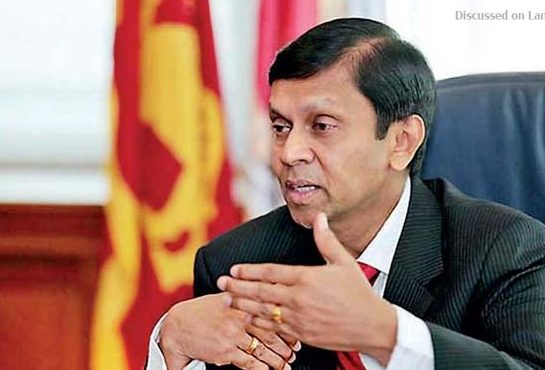Auditor General says SL Debt to GDP Ratio for 2017 is 81.0% and not 77.6%
Former Governor the Central Bank of Sri Lanka
* By the end of 2017, according to the Central Bank Annual Report 2017, Government’s Debt Stock increased to Rs.10, 313 billion, and the Debt to GDP ratio to 77.6%; up from Rs.7, 391 billion and 71.3% at end 2014.
* However, Auditor General’s Report points out Government’s Debt Stock is Rs. 10,702 billion; a staggering Rs. 389 billion higher than announced: Report also states Debt to GDP ratio is 81.0%
* Sri Lanka moves into “Highly Indebted State” category
* Just before these figures were announced, authorities go on borrowing spree
* Rupee depreciation from 1st January to 12th June increases value of Debt Stock by a staggering Rs. 196 billion
* Total increase of the Public Debt in May 2018 amounts to Rs. 842 billion
* Total borrowings of the Rajapaksa administration during the year 2014 was Rs. 598 billion
* Govt. now unleashing unconscionable taxes and effecting major increases in prices of public utilities
The Debt to GDP ratio is one of the most important macro-economic indicators in assessing a country’s economy. While it sets out the level of indebtedness of a country in proportion to its Gross Domestic Product, it also provides a measure of its re-payment capacity. Further, a Time-series of Debt to GDP ratios indicates the trend as to whether indebtedness is rising or falling.
Sri Lanka’s Debt to GDP ratio was a very high 91% in 2005, when the Mahinda Rajapaksa administration took office. Thereafter, through a process of sustained growth of the economy, stabilisation of the rupee, increased local and foreign investment, reduction of interest rates, compression of the budget deficit, and containment of inflation, the authorities were able to reduce the Debt to GDP ratio to 71%, by the time that administration was voted out of office in early January 2015.
Since then, the Yahapalanaya management of the economy has pushed the indebtedness of the country towards unacceptable levels, triggered by prolific government expenditure, rapidly depreciating currency, increased interest rates, highly wasteful endeavours, and discouragement of investors. Such outcomes have led to the ballooning of the Debt stock and the escalation of the Debt to GDP ratio, with the Central Bank Annual Report 2017 stating that, as at the end of 2017,the Government’s Debt stock has increased to Rs.10,313 billion and the Debt to GDP ratio had increased to 77.6%; up from Rs.7,391 billion and 71.3% as at end 2014.
However, the Auditor General’s Report on the Financial Statements for 2017 of the Ministry of Finance (which have been released into the Ministry website recently without any publicity), points out that the Sri Lankan Government’s Debt position of Rs. 10,313 billion is incorrect, and that the actual Debt is Rs. 10,702 billion—a staggering Rs. 389 billion (about US$ 2.5 billion) higher!
Such a sum is equivalent to the cumulative investment made by the Rajapaksa Government on the Colombo-Katunayake Expressway, the Norochcholai Coal Power Plant, and the Hambantota Port. The Auditor General also states that the Debt to GDP ratio is not 77.6%,but 81.0%!On that basis, Sri Lanka has now moved into a “Highly Indebted State” category, and it is only a matter of time before that dubious status would seriously impair Sri Lanka’s ability to raise funds.
Fortunately, for the Sri Lankan authorities, just before these dismal figures were made public, they had hurriedly secured some huge long-term loans. In May 2018, the authorities proudly announced that it has borrowed USD 2.5 billion via the issue of International Sovereign Bonds and a further USD 1.0 billion via a Syndicated Loan. Accordingly, the Forex loans amounted USD 3.5 billion or Rs. 556 billion. In addition, Rs 90 billion was borrowed locally via the issue of long-tenor Treasury Bonds. At the same time, the Rupee depreciation from 1st January 2018 up to 12th June 2018 is estimated to have increased the value of the Debt Stock by a further Rs.196 billion. Therefore, the total increase of the Public Debt in the month of May 2018 could be computed at a mind-boggling sum of Rs. 842billion: a sum which is over 6% of GDP! In contrast, the total borrowings of the Rajapaksa administration during the entire year 2014 were Rs. 598 billion. Such comparison shows the unprecedented and reckless borrowing spree of the yahapalana government.
In addition to the “out-of-control” borrowings, the present government is also unleashing a vicious cocktail of unconscionable taxes on struggling businesses and hapless people, while effecting major increases in prices of public utilities as well. As a result, all stakeholders of the Sri Lankan economy are now reeling under this twin-barrage. Adding to these woes, a few days ago, the Prime Minister announced that he would be considering further increases in the Value Added Tax rates in the near future, even while increasing the number of Ministers just to keep the disgruntled MPs at bay. This callous attitude shows that the current inept and corrupt government is fast running out of options, and is losing control of the economy, thereby, causing the once-vibrant Sri Lankan economy to drift without a vision, direction or focus.

